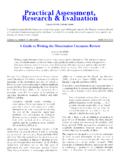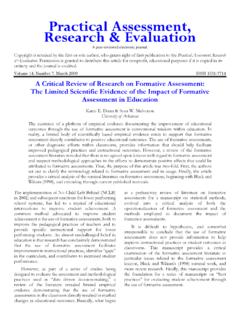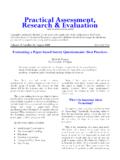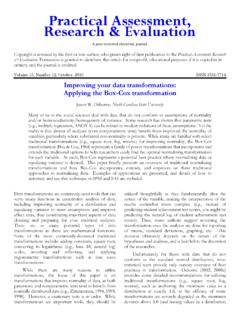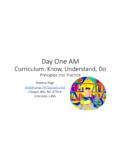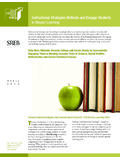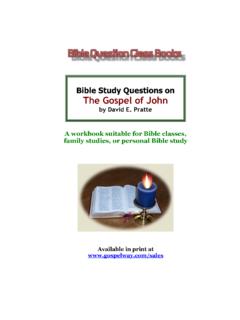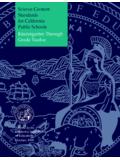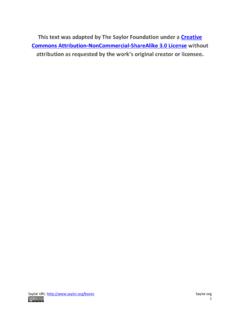Transcription of Classroom Test Construction: The Power of a Table …
1 A peer-reviewed electronic journal. Copyright is retained by the first or sole author, who grants right of first publication to the Practical Assessment, Research & Evaluation. Permission is granted to distribute this article for nonprofit, educational purposes if it is copied in its entirety and the journal is credited. PARE has the right to authorize third party reproduction of this article in print, electronic and database forms. Volume 18, Number 3, February 2013 ISSN 1531-7714 Classroom Test Construction: The Power of a Table of Specifications Helenrose Fives & Nicole DiDonato-Barnes Montclair State University Classroom tests provide teachers with essential information used to make decisions about instruction and student grades. A Table of specification (TOS) can be used to help teachers frame the decision making process of test construction and improve the validity of teachers evaluations based on tests constructed for Classroom use.
2 In this article we explain the purpose of a TOS and how to use it to help construct Classroom tests. But we only talked about Grover Cleveland for like 2 seconds last week. Why would she put that on the exam? You know how teachers they re always trying to trick you. Yeah, they find the most nit-picky little details to put on their tests and don t even care if the information is important. It s just not fair. I studied everything we discussed in class about the Gilded Age and the things she made a big deal about, like comparing the industrialized north to the agriculture in the south. I really thought I understood what was going on how the economy and way of life changed with industry, railroads, and unions. And to think all she asked was What was the South s economic base! Oh and What were Grover Cleveland s terms as president? Really? Grrr. As a student have you ever felt that the test you studied for was completely or partially unrelated to the class activities you experienced?
3 As a teacher have you ever heard these complaints from students? This is not an uncommon experience in most classrooms. Frequently there is both a real and perceived mismatch between the content examined in class and the material assessed on an end of chapter/unit test. This lack of coherence leads to a test that fails to provide evidence from which teachers can make valid judgments about students progress (Brookhart, 1999). One strategy teachers can use to mitigate this problem is to develop a Table of Specifications (TOS). What is a Table of Specifications? A TOS, sometimes called a test blueprint, is a Table that helps teachers align objectives, instruction, and assessment ( , Notar, Zuelke, Wilson, & Yunker, 2004). This strategy can be used for a variety of assessment methods but is most commonly associated with constructing traditional summative tests. When constructing a test, teachers need to be concerned that the test measures an adequate sampling of the class content at the cognitive level that the material was taught.
4 The TOS can help teachers map the amount of class time spent on each objective with the cognitive level at which each objective was taught thereby helping teachers to identify the types of items they need to include on their tests. There are many approaches to developing and using a TOS advocated by measurement experts ( , Anderson, Krathwohl, Airasian, Cruikshank, Mayer, Pintrich, Raths, & Wittrock, 2001, Gronlund, 2006; Reynolds, Livingston, & Wilson, 2006). In this article, we describe one approach to using a TOS developed for practical Classroom application. Our approach to the TOS is intended to help Classroom teachers develop summative assessments that are well aligned to the subject matter studied and the cognitive processes used during instruction. However, for this strategy to be helpful in your teaching practice, you need to make it your own and Practical Assessment, Research & Evaluation, Vol 18, No 3 Page 2 Fives & DiDonato-Barnes, Table of Specifications consider how you can adapt the underlying strategy to your own instructional needs.
5 There are different versions of these tables or blueprints ( , Linn & Gronlund, 2000; Mehrens & Lehman, 1973; Nortar et al., 2004), and the one presented here is one that we have found most useful in our own teaching. This tool can be simplified or complicated to best meet your needs in developing Classroom tests. What is the Purpose of a Table of Specifications? In order to understand how to best modify a TOS to meet your needs, it is important to understand the goal of this strategy: improving validity of a teacher s evaluations based on a given assessment. Validity is the degree to which the evaluations or judgments we make as teachers about our students can be trusted based on the quality of evidence we gathered (Wolming & Wilkstrom, 2010). It is important to understand that validity is not a property of the test constructed, but of the inferences we make based on the information gathered from a test.
6 When we consider whether or not the grades we assign to students are accurate we are questioning the validity of our judgment. When we ask these questions we can look to the kinds of evidence endorsed by researchers and theorists in educational measurement to support the claims we make about our students (AERA, APA, NCME, 1999). For Classroom assessments two sources of validity evidence are essential: evidence based on test content and evidence based on response process (APA, AERA, NCME, 1999). At the beginning of this article the students complained about a lack of coherence between the subject matter discussed in class (test content evidence) as well as the kind of thinking required on the test (response process evidence). Test content evidence was questioned by the first student who stated But we only talked about Grover Cleveland for like 2 seconds last In this comment the student is concerned that the material (content) he studied and the teacher emphasized was not on the test.
7 Evidence based on test content underscores the degree to which a test (or any assessment task) measures what it is designed (or supposed) to measure (Wolming & Wilkstrom, 2010). If an Algebra I teacher gave an exam on the proof of Pythagoras theorem and based her Algebra I grades on her students response to that exam, most of us would argue that the exam and the grades were unjustified. In assessment we would say that her judgment lacked evidence of test content agreement, because the evidence used (data from a geometry test) to make the judgment did not reflect students understanding of the targeted content (algebra). Your Classroom tests must be aligned to the content (subject matter) taught in order for any of your judgments about student understanding and learning to be meaningful. Essentially, with test-content evidence we are interested in knowing if the measured (tested/assessed) objectives reflect what you claim to have measured.
8 Response process evidence is the second source of validity evidence that is essential to Classroom teachers. Response process evidence is concerned with the alignment of the kinds of thinking required of students during instruction and during assessment (testing) activities. For example, the last student in the opening scenario implied that class time was spent comparing the U. S. North and South during the Gilded Age (circa 1877-1917) yet on the test the teacher asked a low level recall question about the economic base of the South. The inclusion of a question such as this is supported by evidence of test-content, the student recalled the topic mentioned. But the depth of processing required to compare the North and South during instruction involved more attention and deeper understanding of the material. This last student clearly felt that there was a lack of congruence in the kind of thinking required for this test and during instruction.
9 Sometimes the tests teachers administer have evidence for test content but not response process. That is, while the content is aligned with instruction the test does not address the content at the same depth or level of meaning that was experienced in class. When students feel that they are being tricked or that the test is overly specific (nit-picky) there is probably an issue related to response process at play. As test constructors we need to concern ourselves with evidence of response process. One way to do this is to consider whether the same kind of thinking is used during class activities and summative assessments. If the class activity focused on memorization then the final test Practical Assessment, Research & Evaluation, Vol 18, No 3 Page 3 Fives & DiDonato-Barnes, Table of Specifications should also focus on memorization and not on a thinking activity that is more advanced.
10 Table 1 provides two possible test items to assess the understanding of sources of validity evidence. In Table 1, Option A assesses whether or not students can recognize a definition of test content validity evidence. Option B assesses whether or not students can evaluate the prompt and apply the type of validity evidence described in the scenario. Thus, these two items require different levels of thinking and understanding of the same content ( , recognizing vs. evaluating/applying). Evidence of response process ensures that Classroom tests assess the level of thinking that was required for students during their instructional experiences. Table 1: Examples of items assessing different cognitive levels Option A The degree to which the test assesses the appropriate content material it intends to measure refers to evidence of: a. test content. b. response process. c. criterion relationships. d.

